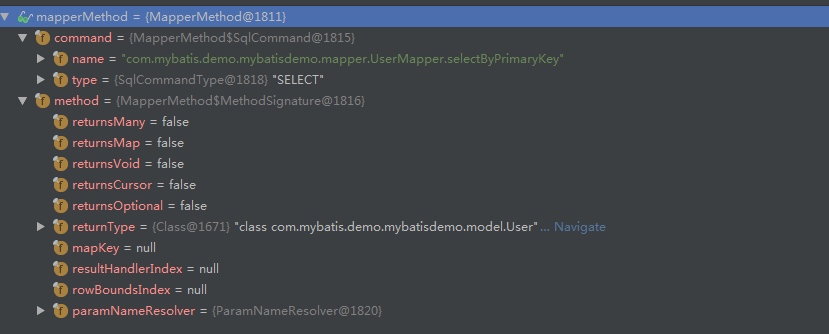一、前言
在先了解mybatis查询之前,先大致了解下以下代码的为查询做了哪些铺垫,在这里我们要事先了解,myabtis会默认使用DefaultSqlSessionFactory作为sqlSessionFactory的实现类,而sqlSession的默认实现类为DefaultSqlSession
public static SqlSessionFactory getSessionFactory() throws IOException {
Reader reader = Resources.getResourceAsReader("mybatis/mybatis-config.xml");
SqlSessionFactoryBuilder builder = new SqlSessionFactoryBuilder();
return builder.build(reader);
}
获取mybatis的配置文件流,交给sqlSessionFactoryBuilder进行解析,在这里只会涉及到一部分,具体,请大家移步mybatis源码进行分析
解析大致步骤(以下说的配置文件,是mybatis配置数据库连接信息的那个配置文件,不是mapper.xml文件)
解析配置文件的核心类在XMLConfigBuilder类中,
代码如下
public Configuration parse() {
if (parsed) {
throw new BuilderException("Each XMLConfigBuilder can only be used once.");
}
parsed = true;
parseConfiguration(parser.evalNode("/configuration"));
return configuration;
}
private void parseConfiguration(XNode root) {
try {
// 解析properties节点信息
propertiesElement(root.evalNode("properties"));
// 解析settings节点配置信息,其中二级缓存的总开关就是这里配置,当然mybatis默认是开启的,详细见Configuration类中的cacheEnabled属性
Properties settings = settingsAsProperties(root.evalNode("settings"));
loadCustomVfs(settings);
loadCustomLogImpl(settings);
// 解析别名
typeAliasesElement(root.evalNode("typeAliases"));
// 解析插件
pluginElement(root.evalNode("plugins"));
// 这个节点一般不进行配置,myabtis也提供了一个默认实现类DefaultObjectFactory,除非自定义对象工厂实现,才需配置
objectFactoryElement(root.evalNode("objectFactory"));
objectWrapperFactoryElement(root.evalNode("objectWrapperFactory"));
reflectorFactoryElement(root.evalNode("reflectorFactory"));
settingsElement(settings);
// read it after objectFactory and objectWrapperFactory issue #631
environmentsElement(root.evalNode("environments"));
databaseIdProviderElement(root.evalNode("databaseIdProvider"));
// 处理java类型和数据库类型的转换,mybatis提供了许多默认实现,详细见TypeHandlerRegistry类,如果需自定义,可在此节点中进行配置
typeHandlerElement(root.evalNode("typeHandlers"));
// 这也是一个核心的配置,mapperElement方法会对mapper.xml文件内容进行一个解析
mapperElement(root.evalNode("mappers"));
} catch (Exception e) {
throw new BuilderException("Error parsing SQL Mapper Configuration. Cause: " + e, e);
}
}
解析mapper.xml文件 的类XMLMapperBuilder,
public void parse() {
// 也就是检测配置文件配置的mapper节点有没有加载到configuration类中,防止重复加载
if (!configuration.isResourceLoaded(resource)) {
configurationElement(parser.evalNode("/mapper"));
configuration.addLoadedResource(resource);
// 这个是绑定,mapper接口的,当处理成功,在configuration类中的mapper注册器中,会添加一个mapper
bindMapperForNamespace();
}
parsePendingResultMaps();// 解析resultMap节点
parsePendingCacheRefs(); // 解析缓存节点,如<cache-ref/>
parsePendingStatements();// 解析select|update等节点,并封装成mappedStatement类
}
其中bindMapperForNamespace()方法的操作会导致以下结果
在configuration类中的MapperRegistry属性中添加一个mapper,结果存储在MapperRegistry类的一个map中,key为mapper的class value为一个代理工厂,负责产生mapper接口代理类。
二、查询操作
当我们使用要使用mybatis进行查询操作,无非大致就是两种方式
/**
* 通过mapper接口形式查询数据
*/
@Test
public void testSelectByMapper() throws IOException {
SqlSession sqlSession = MybatisUtil.getSessionFactory().openSession();
UserMapper mapper = sqlSession.getMapper(UserMapper.class);
User user = mapper.selectByPrimaryKey(10);
System.out.println(user);
sqlSession.close();
}
/**
* 通过mapper接口的全限定名来进行查询
* @throws IOException
*/
@Test
public void testSelectByString() throws IOException {
SqlSessionFactory sessionFactory = MybatisUtil.getSessionFactory();
SqlSession sqlSession = sessionFactory.openSession();
User user = sqlSession.selectOne("com.mybatis.demo.mybatisdemo.mapper.UserMapper.selectByPrimaryKey",10);
System.out.println(user);
sqlSession.close();
}
先来看第一种的分析,当我们点击getMapper进去,它会去调用configuration类中getMapper方法,就如上面介绍的解析出mapper节点后,会存储在configuration类中的mapper注册器中,
// defaultSqlSession类
public <T> T getMapper(Class<T> type) {
return configuration.<T>getMapper(type, this);
}
//configuration类
public <T> T getMapper(Class<T> type, SqlSession sqlSession) {
return mapperRegistry.getMapper(type, sqlSession);
}
// 最终获取mapper对象的方法,其主要是创建一个mapper代理工厂,我们都知道mybatis的mapper接口是没有实现类的,
// 但是我们直接查询是能获取数据,这里起作用的就是代理(采用的是jdk动态代理)
public <T> T getMapper(Class<T> type, SqlSession sqlSession) {
final MapperProxyFactory<T> mapperProxyFactory = (MapperProxyFactory<T>) knownMappers.get(type);
if (mapperProxyFactory == null) {
throw new BindingException("Type " + type + " is not known to the MapperRegistry.");
}
try {
return mapperProxyFactory.newInstance(sqlSession);
} catch (Exception e) {
throw new BindingException("Error getting mapper instance. Cause: " + e, e);
}
}
然后最终会经过代理类MapperProxy的invoke方法,进行返回结果。在这里为了更好的能理解这个类,举个例子,步骤如下
先创建一个接口,再使用一个类去实现java的jdk代理的核心接口InvocationHandler,
public interface TestMapper {
User findByUserId(Integer id);
}
public class MapperProxyTest implements InvocationHandler {
private Class<?> target;
public MapperProxyTest(Class<?> target) {
this.target = target;
}
public Object getProxyInstances(){
return Proxy.newProxyInstance(Thread.currentThread().getContextClassLoader(),new Class[]{target},this);
}
@Override
public Object invoke(Object proxy, Method method, Object[] args) throws Throwable {
if (Object.class.equals(method.getDeclaringClass())) {
return method.invoke(this, args);
}
User user = new User();
user.setPassword("123");
user.setUsername("李四");
user.setAddress("123");
user.setRegistertime(new Date());
user.setCellphone("1111111");
user.setAge(25);
return user;
}
}
测试类
public class MapperTest {
public static void main(String[] args){
MapperProxyTest proxyTest = new MapperProxyTest(TestMapper.class);
TestMapper testMapper = (TestMapper) proxyTest.getProxyInstances();
System.out.println(testMapper.findByUserId(10));
}
}
执行结果
User{id=null, username='李四', password='123', age=25, address='123', cellphone='1111111', registertime=Sat Mar 09 15:02:16 CST 2019}
由上面例子也可以看出最终结果是在invoke方法内,同理在mybatis中的MapperProxy的invoke方法也是负责返回最终结果的
public Object invoke(Object proxy, Method method, Object[] args) throws Throwable {
try {
if (Object.class.equals(method.getDeclaringClass())) {
return method.invoke(this, args);
} else if (isDefaultMethod(method)) {
return invokeDefaultMethod(proxy, method, args);
}
} catch (Throwable t) {
throw ExceptionUtil.unwrapThrowable(t);
}
// 交给了mpperMethod类去处理
final MapperMethod mapperMethod = cachedMapperMethod(method);
return mapperMethod.execute(sqlSession, args);
}
mapperMethod类中有两个重要属性,也就是它的内部类,

也可以很清楚的了解到SqlCommand是用来存储当前执行方法的信息,如全限定名,还有该方法是属于select|update|delete|insert|flush的哪一种,
对于methodSignature,则是纪录该方法的一些信息,如返回值类型,参数等信息,paramNameResolver处理mapper接口中的参数,下面代码中有一个大致的介绍,以后会做一个详细的介绍,这里只贴下代码,只针对select做介绍
public Object execute(SqlSession sqlSession, Object[] args) {
Object result;
switch (command.getType()) {
case INSERT: {
Object param = method.convertArgsToSqlCommandParam(args);
result = rowCountResult(sqlSession.insert(command.getName(), param));
break;
}
case UPDATE: {
Object param = method.convertArgsToSqlCommandParam(args);
result = rowCountResult(sqlSession.update(command.getName(), param));
break;
}
case DELETE: {
Object param = method.convertArgsToSqlCommandParam(args);
result = rowCountResult(sqlSession.delete(command.getName(), param));
break;
}
case SELECT:
if (method.returnsVoid() && method.hasResultHandler()) {// 返回值为void类型,但是有ResultHandler参数,并且只能有一个,不然会报错
executeWithResultHandler(sqlSession, args);
result = null;
} else if (method.returnsMany()) {// 处理返回值类型为集合类型或者数组类型
result = executeForMany(sqlSession, args);
} else if (method.returnsMap()) {//处理返回值类型为Map类型
result = executeForMap(sqlSession, args);
} else if (method.returnsCursor()) {//返回值是否为cursor类型
result = executeForCursor(sqlSession, args);
} else {//其他类型
Object param = method.convertArgsToSqlCommandParam(args);
result = sqlSession.selectOne(command.getName(), param);
if (method.returnsOptional() &&
(result == null || !method.getReturnType().equals(result.getClass()))) {
result = Optional.ofNullable(result);
}
}
break;
case FLUSH:
result = sqlSession.flushStatements();
break;
default:
throw new BindingException("Unknown execution method for: " + command.getName());
}
if (result == null && method.getReturnType().isPrimitive() && !method.returnsVoid()) {
throw new BindingException("Mapper method '" + command.getName()
+ " attempted to return null from a method with a primitive return type (" + method.getReturnType() + ").");
}
return result;
}
这里只介绍select部分中常用返回多个实例对象的情况,也就是返回值为集合类型。
private <E> Object executeForMany(SqlSession sqlSession, Object[] args) {
List<E> result;
// 将mapper接口的参数名称和args整成一个map结构,最后在会将值赋给sql中对应的变量
// 在3.5版本中,默认的mapper结构(假如没使用@param注解或者处于jdk1.8版本中在代码编译时加上 -parameters 参数),结构为
// param1 -> args[0] param2 -> args[1]
// arg0 -> args[0] arg1 -> args[1] mybatis之前有些版本不是arg0 而是0 1 。。数字代替。
Object param = method.convertArgsToSqlCommandParam(args);
if (method.hasRowBounds()) {// 处理参数中带有rowBounds参数
RowBounds rowBounds = method.extractRowBounds(args);
result = sqlSession.<E>selectList(command.getName(), param, rowBounds);
} else {// 其它情况
result = sqlSession.<E>selectList(command.getName(), param);
}
// issue #510 Collections & arrays support
// 说明返回类型不是集合List类型,而是数组类型或其它集合类型。
if (!method.getReturnType().isAssignableFrom(result.getClass())) {
if (method.getReturnType().isArray()) {
return convertToArray(result);
} else {
return convertToDeclaredCollection(sqlSession.getConfiguration(), result);
}
}
return result;
}
从上面知道,最终还是回到了sqlSession里面,
@Override
public <E> List<E> selectList(String statement, Object parameter, RowBounds rowBounds) {
try {
MappedStatement ms = configuration.getMappedStatement(statement);
return executor.query(ms, wrapCollection(parameter), rowBounds, Executor.NO_RESULT_HANDLER);
} catch (Exception e) {
throw ExceptionFactory.wrapException("Error querying database. Cause: " + e, e);
} finally {
ErrorContext.instance().reset();
}
}
MappedStatement存储的其实就是对每一个select|update|delete|insert 标签的解析结果
关于MappedStatement是怎么解析得来的,又是怎么存储在Configuration中,可沿着以下路线进行查看
SqlSessionFactoryBuilder ---> build方法
XMLConfigBuilder ----> parse、parseConfiguration、mapperElement方法
XMLMapperBuilder ----> parse、parsePendingStatements、parseStatementNode
MapperBuilderAssistant ----> addMappedStatement
这里不做过多介绍,详情见源码
在selectList中executor的默认实现类是,SimpleExecutor,不过它还由Configuration类中的一个属性决定最后的类型,
public Executor newExecutor(Transaction transaction, ExecutorType executorType) {
executorType = executorType == null ? defaultExecutorType : executorType;
executorType = executorType == null ? ExecutorType.SIMPLE : executorType;
Executor executor;
if (ExecutorType.BATCH == executorType) {
executor = new BatchExecutor(this, transaction);
} else if (ExecutorType.REUSE == executorType) {
executor = new ReuseExecutor(this, transaction);
} else {
executor = new SimpleExecutor(this, transaction);
}
// 如果cacheEnabled为true,其实这个属性默认为true的,
// 则由CachingExecutor进行包装,也就是常说的装饰设计模式
if (cacheEnabled) {
executor = new CachingExecutor(executor);
}
executor = (Executor) interceptorChain.pluginAll(executor);
return executor;
}
最后回到selectList中来,由此可见,调用了CachingExecutor类中的query方法来执行。
@Override
public <E> List<E> query(MappedStatement ms, Object parameterObject, RowBounds rowBounds, ResultHandler resultHandler, CacheKey key, BoundSql boundSql)
throws SQLException {
// 如果不为空,则启用了二级缓存
Cache cache = ms.getCache();
if (cache != null) {
flushCacheIfRequired(ms);
if (ms.isUseCache() && resultHandler == null) {
ensureNoOutParams(ms, boundSql);
@SuppressWarnings("unchecked")
List<E> list = (List<E>) tcm.getObject(cache, key);
if (list == null) {
list = delegate.query(ms, parameterObject, rowBounds, resultHandler, key, boundSql);
tcm.putObject(cache, key, list); // issue #578 and #116
}
return list;
}
}
return delegate.query(ms, parameterObject, rowBounds, resultHandler, key, boundSql);
}
关于二级缓存,相信熟悉的都清楚,要想使用它,需要动两个地方,
一个是mybatis的配置文件,将cacheEnabled设置为true,其实mybatis对这个属性的默认值就是true,所以二级缓存的总开关是打开的。
第二个就是在mpper.xml文件中使用 <cache/> 或<cache-ref/>
这里对缓存不做介绍。
然后调用了BaseExecutor的query方法,这个类起的作用就是对一级缓存进行了操作,最终调用了SimpleExecutor的doQuery方法进行查询。
总结
以上就是这篇文章的全部内容了,希望本文的内容对大家的学习或者工作具有一定的参考学习价值,谢谢大家对的支持。